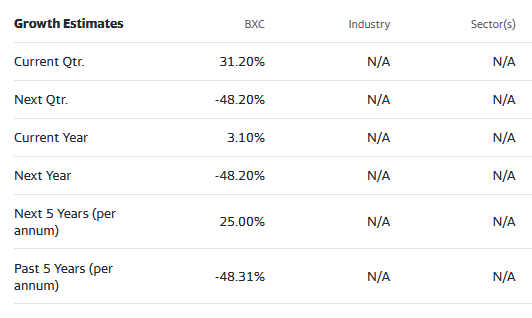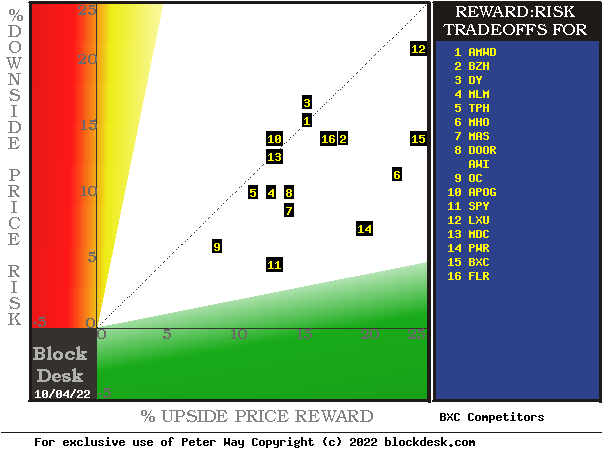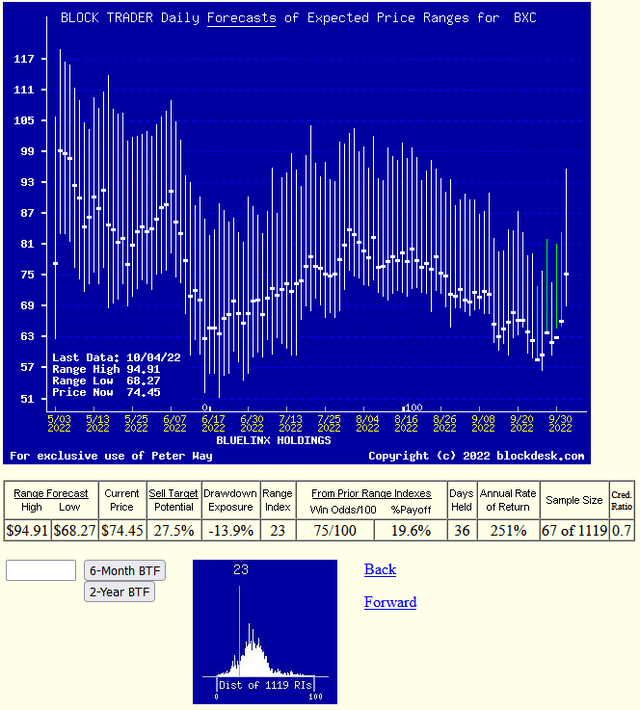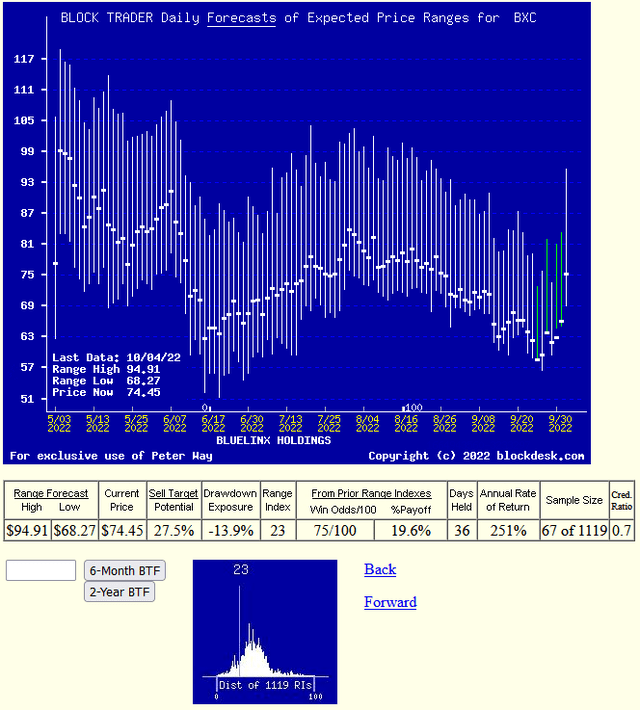Pgiam/iStock via Getty Images
This article repeats the August recommendation on BlueLinx Holdings Inc. (NYSE:BXC).
Recent Forecast Trends of the Primary Subject
Figure 1
(Used with permission.)
Investment Thesis
Intelligent investing in equities requires forecasts of future securities prices. Forecasts which have comparability with forecasts for alternative investment choices. Forecasts which clearly describe both Risk and Reward on a common basis. Universal descriptions, like prospects of gain or loss of capital.
Ultimately that comes down to what prices transactors will pay and accept in agreeable trades. Those prices require a sense of limits as to what will be tolerated as to even considering the negotiation of a trade. Transactions will likely depend on both buyer and seller each envisioning a better different investment prospect situation to subsequently pursue than the one they now are involved with.
Figure 1 presents that potential range of BXC’s stock price as a vertical line between the opposing limits, divided by the day’s closing price into upside and downside prospects.
Those trade-off balances of coming price prospects provide far better value notions than can any single-point estimate of a future outcome.
Because the limits are implied from the knowledgeable actions of negotiators expressed from derivative contract-securities having limited lives, it is important to maintain appropriate forecast time horizons; we regard those horizons as being in the realm of 3-5 months, instead of 3-5 years.
This shortness of forecast imputes a leverage power of compounding from the ability to repeat actions with intended outcomes.
The remainder of this article is simply an updating of the August article. Only the numbers are different; the conclusion is the same. For fundamental analysis content check other Seeking Alpha contributor articles by BXC ticker symbol reference. At least one recently has repeated his recent buy recommendation. This article adds specific coming value comparisons essential to competitive and satisfying portfolio management.
Description of Equity Subject Company
“BlueLinx Holdings Inc., together with its subsidiaries, distributes residential and commercial building products in the United States. The company distributes specialty products comprising engineered wood, industrial products, cedar, molding, siding, metal, and insulation products; and structural products include lumber, plywood, oriented strand boards, rebars and remesh, spruce, and other wood products primarily that are used for structural support in construction projects. It also provides various value-added services and solutions to customers and suppliers. The company serves dealers, specialty distributors, national home centers, and manufactured housing customers through a network of distribution centers. BlueLinx Holdings Inc. was incorporated in 2004 and is headquartered in Marietta, Georgia.
Source: Yahoo Finance
Intelligent investing in equities requires forecasts of future securities prices. Forecasts which have comparability with forecasts for alternative investment choices. Forecasts which clearly describe both Risk and Reward on a common basis. Universal descriptions, like prospects of gain or loss of capital.
Ultimately, that comes down to what prices transactors will pay and accept in agreeable trades. Those prices require a sense of limits as to what will be tolerated as to even considering the negotiation of a trade. Transactions will likely depend on both buyer and seller each envisioning a better different investment prospect situation to subsequently pursue than the one they now are involved with.
Figure 1 presents that potential range of BXC’s stock price as a vertical line between the opposing limits, divided by the day’s closing price into upside and downside prospects.
Those trade-off balances of coming price prospects provide far better value notions than can any single-point estimate of a future outcome.
Because the limits are implied from the knowledgeable actions of negotiators expressed from derivative contract-securities having limited lives, it is important to maintain appropriate forecast time horizons; we regard those horizons as being in the realm of 3-5 months, instead of 3-5 years.
This shortness of forecast imputes a leverage power of compounding from the ability to repeat actions with intended outcomes.
The remainder of this article is simply an updating of the August article. Only the numbers are different; the conclusion is the same. For fundamental analysis content check other Seeking Alpha contributor articles by ticker symbol reference. At least one recently has repeated his recent buy recommendation. This article adds specific coming value comparisons essential to competitive and satisfying portfolio management.
Yahoo Finance
These growth estimates have been made by and are collected from Wall Street analysts to suggest what conventional methodology currently produces. The typical variations across forecast horizons of different time periods illustrate the difficulty of making value comparisons when the forecast horizon is not clearly defined.
Risk and Reward Balances Among Construction Industry Participants
Figure 2
blockdesk.com
(Used with permission.)
The risk dimension is of actual price drawdowns at their most extreme point while being held in previous pursuit of upside rewards similar to the ones currently being seen. They are measured on the red vertical scale. Reward expectations are measured on the green horizontal scale.
Both scales are of percent change from zero to 25%. Any stock or ETF whose present risk exposure exceeds its reward prospect will be above the dotted diagonal line. Capital-gain-attractive to-buy issues are in the directions down and to the right.
Our principal interest is in BXC at location [15]., at the right-hand Reward boundary. A “market index” norm of reward~risk tradeoffs is offered by SPY at [11]. Most appealing by this Figure 2 view for wealth-building investors is BXC.
Comparing competitive features of Construction Providers
The Figure 2 map provides a good visual comparison of the two most important aspects of every equity investment in the short term. There are other aspects of comparison which this map sometimes does not communicate well, particularly when general market perspectives like those of SPY are involved. Where questions of “how likely’ are present other comparative tables, like Figure 3, may be useful.
Yellow highlighting of the table’s cells emphasize factors important to securities valuations and the security BXC of most promising of near capital gain as ranked in column [R]. Pink cell highlights warn of sub-standard aspects in expectations of historic risk to reward [T] or size of information sample [ L].
Figure 3
(used with permission)
Why Do All This Math?
Figure 3’s purpose is to attempt universally comparable answers, stock by stock, of a) How BIG the prospective price gain payoff may be, b) how LIKELY the payoff will be a profitable experience, c) how SOON it may happen, and d) what price drawdown RISK may be encountered during its active holding period.
Readers familiar with our analysis methods after quick examination of Figure 3 may wish to skip to the next section viewing price range forecast trends for BXC.
Column headers for Figure 3 define investment-choice preference elements for each row stock whose symbol appears at the left in column [A]. The elements are derived or calculated separately for each stock, based on the specifics of its situation and current-day MM price-range forecasts. Data in red numerals are negative, usually undesirable to “long” holding positions. Table cells with yellow fills are of data for the stocks of principal interest and of all issues at the ranking column, [R].
The price-range forecast limits of columns [B] and [C] get defined by MM hedging actions to protect firm capital required to be put at risk of price changes from volume trade orders placed by big-$ “institutional” clients.
[E] measures potential upside risks for MM short positions created to fill such orders, and reward potentials for the buy-side positions so created. Prior forecasts like the present provide a history of relevant price draw-down risks for buyers. The most severe ones actually encountered are in [F], during holding periods in effort to reach [E] gains. Those are where buyers are emotionally most likely to accept losses.
The Range Index [G] tells where today’s price lies relative to the MM community’s forecast of upper and lower limits of coming prices. Its numeric is the percentage proportion of the full low to high forecast seen below the current market price.
[H] tells what proportion of the [L] sample of prior like-balance forecasts have earned gains by either having price reach its [B] target or be above its [D] entry cost at the end of a 3-month max-patience holding period limit. [ I ] gives the net gains-losses of those [L] experiences.
What makes BXC most attractive in the group at this point in time is its ability to produce capital gains most consistently at its present operating balance between share price risk and reward at the Range Index [G]. Credibility of the [E] upside prospect as evidenced in the [I] payoff at +23% is shown in [N]. For BXC it is .71 or 7+ out of 10.
Further Reward~Risk tradeoffs involve using the [H] odds for gains with the 100 – H loss odds as weights for N-conditioned [E] and for [F], for a combined-return score [Q]. The typical position holding period [J] on [Q] provides a figure of merit [fom] ranking measure [R] useful in portfolio position preferencing. Figure 2 is row-ranked on [R] among alternative candidate securities, with BXC in top rank.
Along with the candidate-specific stocks these selection considerations are provided for the averages of some 3,000 stocks for which MM price-range forecasts are available today, and 20 of the best-ranked (by fom) of those forecasts, as well as the forecast for S&P500 Index ETF (SPY) as an equity-market proxy.
Current-market index SPY is not competitive as an investment alternative. Its Range Index of 37 indicates 2/3rds of its forecast range is to the upside, but less than 3/4 of previous SPY forecasts at this range index produced profitable outcomes.
As shown in column [T] of figure 2, those levels vary significantly between stocks. What matters is the net gain between investment gains and losses actually achieved following the forecasts, shown in column [I]. The Win Odds of [H] tells what proportion of the Sample RIs of each stock were profitable. Odds below 80% often have proven to lack reliability.
Recent Forecast Trends of the Primary Subject
Figure 1 (repeat)
(Used with permission.)
Many investors confuse any time-repeating picture of stock prices with typical “technical analysis charts” of past stock price history. These are quite different in their content. Instead, here Figure 1’s vertical lines are a daily-updated visual record of price range forecast limits expected in the coming few weeks and months. The heavy dot in each vertical is the stock’s closing price on the day the forecast was made.
That market price point makes an explicit definition of the price reward and risk exposure expectations which were held by market participants at the time, with a visual display of their vertical balance between risk and reward.
The measure of that balance is the Range Index (RI).
With today’s RI there is 23% upside price change in prospect. Of the prior 67 forecasts like today’s RI, 50 have been profitable. The market’s actions of prior forecasts became accomplishments of +20% gains in 36 market days.. So history’s advantage could be repeated seven times or more (perhaps in other selections) in a 252 market-day year, which compounds into a CAGR of +251%.
Also please note the smaller low picture in Figure 1. It shows the past 5 year distribution of Range Indexes with the current level visually marked. For BXC by far the largest proportion of recent past forecasts have been of higher prices and Range Indexes.
Conclusion
Based on direct comparisons with PWR, OC and other Construction competitors, there are several clear reasons to prefer a capital gain-seeking buy in BlueLinx Holdings over other examined alternatives.





Be the first to comment